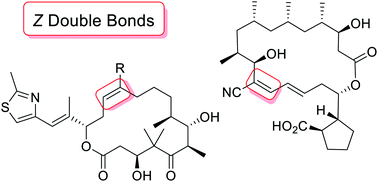Cis double bond formation in polyketide biosynthesis
Abstract
Covering: up to 2020
Polyketides form a large group of bioactive secondary metabolites that usually contain one or more double bonds. Although most of the double bonds found in polyketides are trans or E-configured, several cases are known in which cis or Z-configurations are observed. Double bond formation by polyketide synthases (PKSs) is widely recognised to be catalysed by ketoreduction and subsequent dehydration of the acyl carrier protein (ACP)-tethered 3-ketoacyl intermediate in the PKS biosynthetic assembly line with a specific stereochemical course in which the ketoreduction step determines the usual trans or more rare cis double bond configuration. Occasionally, other mechanisms for the installation of cis double bonds such as double bond formation during chain release or post-PKS modifications including, amongst others, isomerisations or double bond installations by oxidation are observed. This review discusses the peculiar mechanisms of cis double bond formation in polyketide biosynthesis.



 Please wait while we load your content...
Please wait while we load your content...